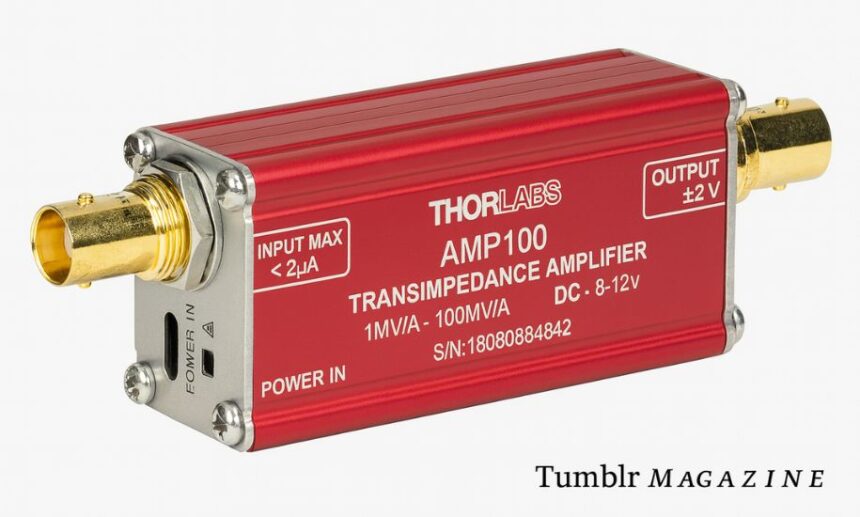Transimpedance amplifiers (TIAs) are critical building blocks in modern optoelectronic systems. Whether it’s for detecting light with photodiodes, ensuring fast signal amplification in scientific setups, or stabilizing current-to-voltage conversion in precise measurements, TIAs enable reliable and accurate performance. Among the many models available, the AMP100 transimpedance amplifier by Thorlabs has gained significant attention for its flexibility, affordability, and unique design.
In this article, we’ll dive deep into the AMP100, explore its specifications, compare it with alternatives like the AMP102 and high-speed variants, discuss photodiode applications, and evaluate why this instrument is widely adopted in labs and research facilities.
What is a Transimpedance Amplifier?
A transimpedance amplifier converts current into a proportional voltage. It’s most commonly used with photodiodes, where incoming light produces a current that must be accurately converted to voltage for measurement or signal processing. Unlike simple resistors that can introduce noise and instability, TIAs maintain bandwidth and stability even with varying photodiode capacitance.
The transimpedance amplifier photodiode combination is foundational in:
-
Optical communication systems
-
Spectroscopy
-
Medical imaging and diagnostics
-
Scientific photodetectors
The AMP100: Key Features and Specifications
The AMP100 transimpedance amplifier is designed as a compact in-line module, powered conveniently through a USB connection. Its structure makes it easy to connect between a photodiode and a readout device without complex integration steps.
Main Specifications:
-
Switchable gains: 1, 10, 100 MV/A
-
Bandwidth: DC – 1 kHz
-
Input current limits: ±2 µA, ±200 nA, or ±20 nA depending on gain
-
Output voltage range: ±1.0 V into 50 Ω (±2.0 V Hi-Z)
-
Max photodiode capacitance: Up to 10 nF, frequency-compensated
-
Polarity switch: Yes, for signal inversion
-
Zero voltage (offset) adjust: Allows compensation for photodiode dark current
-
Form factor: 97 × 32 × 25.4 mm, 80 g
This makes the AMP100 particularly attractive for researchers who need a switchable gain transimpedance amplifier with adjustable zero voltage. It combines flexibility, simplicity, and affordability in a robust, portable module.
AMP100 Transimpedance Amplifier Price
Price is often a deciding factor when choosing lab equipment. The AMP100 transimpedance amplifier price is currently around $575.56 USD directly from Thorlabs. Considering its precision design, integrated controls, and reliability, the cost is reasonable compared to custom-designed amplifiers or bulkier bench-top alternatives.
For budget-conscious users or those requiring broader bandwidth, there are also alternative modules (which we’ll cover later), but for stability and trusted brand support, AMP100 remains a strong candidate.
Why Adjustable Zero Voltage Matters
One of the AMP100’s standout features is its zero voltage (offset) adjust. This allows users to compensate for the dark current of a photodiode — the tiny baseline current present even without light.
Without this adjustment, long-term measurements can drift, and sensitivity may be compromised. With it, the AMP100 ensures cleaner, baseline-stable readings. For experiments demanding low-light detection and precision, this feature is essential.
Switchable Gain: Flexibility in One Device
Many setups require different gains depending on the experiment:
-
Low gain for stronger signals to prevent saturation
-
High gain for weak signals or low-light detection
The switchable gain design of the AMP100 allows users to change between three preset values without replacing hardware or recalibrating the entire setup. This versatility makes it useful in multi-purpose labs and dynamic experimental environments.
Applications with Photodiodes
The AMP100 is most commonly paired with photodiodes in:
-
Optical detection: Measuring intensity variations in spectroscopy or laser alignment
-
Fiber optics testing: Ensuring stable signal conversion in telecommunication research
-
Medical optics: Photodiode detectors in imaging and diagnostic devices
Because it can handle photodiodes up to 10 nF of capacitance, it’s broadly compatible with a wide range of detectors.
High-Speed Alternatives
While the AMP100 is limited to 1 kHz bandwidth, certain applications demand faster response. For those, high speed photodiode amplifier models such as the AMP145 (100 MHz, 2.5 kV/A gain) or AMP140 (10 kV/A at 10 MHz) are more appropriate.
These high-speed TIAs are vital for pulsed laser systems, high-frequency optical signals, or communications research. However, they come at a higher cost and with narrower flexibility compared to the AMP100.
AMP102: The Close Relative
If you like the AMP100 but want more bandwidth, the AMP102 is the natural alternative.
AMP102 Key Specs:
-
Gains: 1, 10, 100 kV/A (switchable)
-
Bandwidth: DC – 100 kHz
-
Price: ~$575.56 (similar to AMP100)
-
Same USB power, BNC connectivity, and compact module design
This model is perfect if your application requires slightly higher frequency response but you still want the switchable gain and offset adjust features.
Transimpedance Amplifier Modules: Broader Market
Beyond Thorlabs, there are other transimpedance amplifier module options worth mentioning:
-
Koheron TIA100: A budget-friendly option priced around €175, with 2 MHz bandwidth and low input noise (5 pA/√Hz).
-
TI OPA3S328-based designs: Offer advanced switched-gain precision, often used in custom setups.
These alternatives may appeal to smaller labs or educational institutions where cost is a stronger factor than having branded, laboratory-grade hardware.
AMP100 vs. AMP102 vs. Alternatives
| Feature | AMP100 | AMP102 | High-Speed (AMP145) | Koheron TIA100 |
|---|---|---|---|---|
| Price | $575.56 | $575.56 | Higher | €175 |
| Gains | 1, 10, 100 MV/A | 1, 10, 100 kV/A | Fixed (2.5 kV/A etc) | Fixed |
| Bandwidth | DC – 1 kHz | DC – 100 kHz | Up to 100 MHz | 2 MHz |
| Adjustable Zero Voltage? | Yes | Yes | Varies | No |
| Form factor | Compact USB module | Compact USB module | Compact inline | Compact PCB |
This comparison highlights that the AMP100 is perfect for stable, low-frequency applications; AMP102 expands into medium-bandwidth needs; and high-speed amplifiers handle specialized photonics.
Why Choose AMP100?
The AMP100 transimpedance amplifier is ideal if:
-
Your work involves photodiodes with capacitances up to 10 nF
-
You need switchable gain with adjustable zero voltage
-
You value compactness and USB power over bulky bench-top gear
-
You require reliable, stable current-to-voltage conversion at low to mid-range bandwidths
It’s not the fastest amplifier, but it is a versatile, budget-friendly choice that balances flexibility and performance.
Final Thoughts
The AMP100 transimpedance amplifier remains a trusted choice in labs and research environments for its affordability, flexibility, and compact form factor. With switchable gain settings, adjustable zero voltage compensation, and compatibility with a wide range of photodiodes, it strikes an excellent balance for users who need reliability without the overhead of high-end, high-speed models.
For applications demanding more bandwidth, the AMP102 or dedicated high-speed photodiode amplifiers like the AMP145 can be considered. For those looking for cost-effective modules, alternatives such as the Koheron TIA100 are viable.
Ultimately, whether you’re working on spectroscopy, telecommunications, or photonics research, the AMP100 provides a dependable foundation.
If you’d like more in-depth photonics articles and amplifier reviews, visit Tumblr Magazine — a space where science and technology insights are shared for curious minds.







